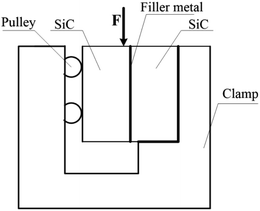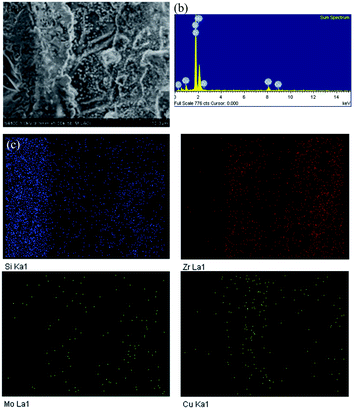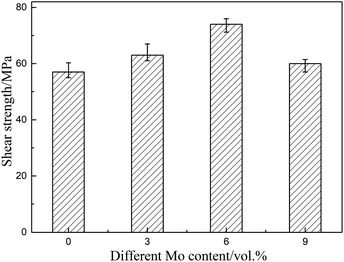 Open Access Article
Open Access ArticleMicrostructure and properties of SiC ceramic brazed with Zr–Cu composite filler metal
Bofang Zhou *,
Taohua Li,
Hongxia Zhang* and
Junliang Hou
*,
Taohua Li,
Hongxia Zhang* and
Junliang Hou
School of Materials Science and Engineering, Hubei University of Automotive Technology, Shiyan, Hubei 442002, PR China. E-mail: hbatzbf@163.com
First published on 6th August 2021
Abstract
The microstructure and properties of SiC ceramic brazed with Zr–Cu composite filler metal were investigated. Combined with the brazing experiment, the microstructure of the interface reaction layer and the brazed SiC ceramic joint was analyzed, and the shear strength was used to evaluate the mechanical properties of the joint. The results show that both Zr–Cu + SiCp and Zr–Cu + Mo composite filler metals can braze SiC ceramic, and the products of the interface reaction layer are mainly ZrC and Zr2Si. The addition of SiCp and Mo to Zr–Cu-based composite filler metal improves the nuclear properties of the composite filler metal and its joint, reduces the coefficient of thermal expansion of the composite filler metal and SiC ceramic joint, and improves the mechanical properties of the joint. The shear properties of the joint increase with the increase of the content of SiCp and Mo in the Zr–Cu composite filler metals. The shear strength of the joint reaches the maximum (82 MPa) when the content of SiC particles is 10 vol% of the Zr–Cu + SiCp composite filler metal, and the average value of the shear strength reaches the maximum of 74 MPa when the content of Mo is 6 vol% of the Zr–Cu + Mo composite filler metal.
1. Introduction
Zirconium alloy has been used in nuclear cladding materials since the development of nuclear power technology.1,2 However, the nuclear leakage accident of Fukushima nuclear power station in Japan is related to the properties of zirconium alloy, that is, Zr alloy loses strength and swells above 500 °C, and reacts with hot water vapor at high temperature to produce hydrogen which causes explosions.3 Due to the advantages of the SiC ceramic material, such as higher fuel consumption than zirconium alloy, difficulty of reaction with radioactive water vapor at high temperature and so on, it is considered that could possibly replace zirconium alloy and become the 4th generation of nuclear power plant cladding material,4 and related research work has been carried out. However, the joining problem of SiC ceramic is still one of the bottlenecks of its application in nuclear industry.The joining methods of SiC ceramic mainly include brazing,5,6 diffusion bonding7,8 and reactive bonding.9 Among them, brazing SiC ceramic can obtain ideal joints at lower temperature and shorter time, and is the most possible joining method to realize mass production. However, the traditional Ag-based,5,6 Cu-based,10 Ti-based,11 Ni-based12 filler metals cannot meet the requirements of both high-temperature performance and nuclear performance in the harsh environment of nuclear reactor.
The research group innovatively proposed Zr-based filler metal for brazing SiC ceramic, the wetting behavior, brazing process and joining mechanism between 80Zr20Cu (wt%) (Zr–Cu) filler metal and SiC ceramic are mainly investigated, and found that Zr–Cu filler metal can better achieve SiC ceramic brazing,13–15 but due to the great difference of physical properties between Zr–Cu filler metal and SiC ceramic, the joint residual stress is large, which affects the mechanical property. At the same time, as the cladding material of nuclear fuel, SiC ceramic needs to consider the nuclear properties of the filler metal, and the 3rd component is added to Zr–Cu filler metal to form Zr–Cu composite filler metal to improve the related properties of filler metal and brazed joint.16,17 Moreover, the physical and chemical properties of SiC ceramic particles are similar to that of the base material SiC ceramic. The element Mo has a lower coefficient of thermal expansion, which can adjust the coefficient of thermal expansion of the filler metal and SiC ceramic, so as to improve the properties of the joint. In the paper, 80Zr20Cu (wt%) filler metal was used as matrix, and different contents of SiCp and Mo are added to form Zr–Cu + SiCp and Zr–Cu + Mo composite filler metals. The effects of two kinds of Zr–Cu composite filler metal on microstructure and mechanical properties of brazing SiC ceramic joint were investigated. The research laid a theoretical foundation and technical guidance for the development of brazing filler metal and brazing technology for nuclear SiC ceramic.
2. Materials and methods
Reactive bonded silicon carbide (RBSiC) was used in the brazing experiment, and the properties of the SiC ceramic with 20 wt% free silicon are shown in Table 1. 80Zr–20Cu (wt%) (Zr–Cu filler metal) is used as the filler metal matrix, on the basis of which SiC particles (about 20 μm) and Mo (about 30 μm) with different contents are added to form Zr–Cu + SiCp and Zr–Cu + Mo composite filler metals. SiC ceramic and composite filler metals were processed into shapes 20 × 10 × 10 mm and 20 × 10 × 0.2 mm, and then polished with 2000# diamond grinding disc and cleaned with ultrasonic wave in acetone for 30 min before the brazing experiment. A “sandwich” structure (SiC ceramic/composite filler metals/SiC ceramic) was formed and placed in a vacuum brazing furnace (VQS-335, Shenyang). The samples were heated to brazing temperature at 1200 °C with the heating rate of 4 °C min−1 and holding time for 20 min, and then cooling to room temperature with the rate of 4 °C min−1. In order to prevent the filler metals from oxidation and ensure the brazing quality, it is necessary to control its high vacuum degree in the furnace of the brazing process.| Maximum temperature of application | Density | Open porosity | Thermal conductivity | Coefficient of thermal expansion |
|---|---|---|---|---|
| 1380 °C | >3.02 g cm−3 | <0.1% | 74 W m−1 K−1 | 4.5 × 10−6 K−1 |
The phases of the composite filler metals and interfacial reaction layer were measured by XRD (XRD, Empyrean, Netherlands). The microstructure of the SiC ceramic joint and composite filler metals that using the corrosive agent (5 vol% HF + 5 vol% HNO3 + 90 vol% H2O) were analyzed by SEM (scanning electron microscope, S-4800, Hitachi, Japan) with EDS. The schematic of the shear strength test is shown in Fig. 1, and the shear strength of the brazing SiC ceramic joint is the average of the three specimens, which was tested by materials testing machine (REGER-300, Shenzhen) with a punch movement rate of 0.5 mm min−1 at room temperature.
3. Results and discussion
3.1. Microstructure and properties of joint with Zr–Cu + SiCp composite filler metal
When the brazing temperature is 1200 °C for brazing SiC ceramic with heating rate is 4 °C min−1 and the holding time for 20 min, the microstructure of the SiC ceramic joint is shown in Fig. 2. It can be found that Zr–Cu + SiCp composite filler metals with different content of SiC particles can realize the brazing of SiC ceramic.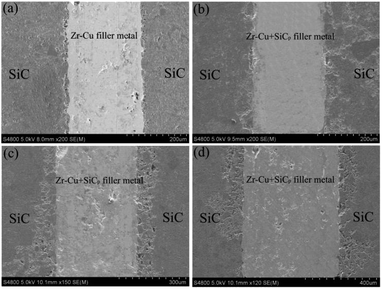 | ||
| Fig. 2 Microstructure of SiC ceramic brazing joint with Zr–Cu + SiCp filler metal with different content of SiC particles: (a) 0, (b) 5 vol%, (c) 10 vol%, (d) 15 vol%. | ||
The microstructure of Zr–Cu + 10SiCp (vol%) filler metal after being corroded by corrosive agent is shown in Fig. 3. There are almost no SiC particles with original size in the filler metal, and the size of SiC particles becomes very small and disperses in the filler metal. This is mainly due to the reaction of SiC particles with Zr–Cu alloy at high temperature. The XRD of Zr–Cu + 10SiCp (vol%) filler metal is shown in Fig. 3(b). It can be seen that the materials produced by the reaction are mainly ZrC and Zr2Si. Through the surface scanning of the composite filler metal, it can be seen that Zr and Cu are the main elements in the filler metal, and the distribution is more uniform, while Si and C are less, and dispersed in the Zr–Cu filler metal.
 | ||
| Fig. 3 (a) Microstructure and distribution of element of Zr–Cu + 10SiCp (vol%) filler metal/SiC, (b) the XRD of the filler metal. | ||
The microstructure of Zr–Cu + 10SiCp (vol%) filler metal after being corroded by corrosive agent is shown in Fig. 3. There are almost no SiC particles with original size in the filler metal, and the size of SiC particles becomes very small and disperses in the filler metal. This is mainly due to the reaction of SiC particles with Zr–Cu alloy at high temperature. The XRD of Zr–Cu + 10SiCp (vol%) filler metal is shown in Fig. 3(b). It can be seen that the materials produced by the reaction are mainly ZrC and Zr2Si. Through the surface scanning of the composite filler metal, it can be seen that Zr and Cu are the main elements in the filler metal, and the distribution is more uniform, while Si and C are less, and dispersed in the Zr–Cu filler metal. A transition region with a certain thickness is formed in the interface reaction layer. It is the interface reaction layer that successfully realizes the brazing between Zr–Cu + 10SiCp (vol%) composite filler metal and SiC ceramic.
The shear strength of SiC ceramic joint brazed by Zr–Cu + SiCpcomposite filler metal with different content of SiC particles is shown in Fig. 4. It can be found that the shear strength of brazing SiC ceramic joint increases with the increase of SiC particle content in the composite filler metal. When the content of SiC particle is 10 vol%, the shear strength of the joint reaches the maximum, an average value of 82 MPa, and the strength of the joint decreases with the increase of SiC particle content in the composite filler metal. On the one hand, SiC particles can react with the Zr–Cu filler metal, on the other hand, SiC particles dispersed in the filler metal can improve the strength of the composite filler metal. When the content of SiC particles is too high (15 vol%), the filler metal mainly reacts with SiC particles, and there is not enough active element Zr to react with SiC ceramic, resulting in low strength of brazed joint.
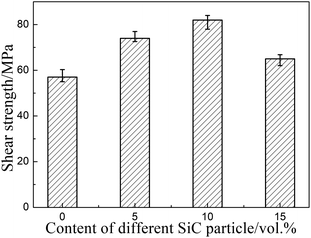 | ||
| Fig. 4 Shear strength of SiC ceramic brazed joint with different content of SiC particle of Zr–Cu + SiCp filler metal. | ||
The addition of SiC particles can effectively improve the coefficient of thermal expansion of the filler metal. The filler metal with low coefficient of thermal expansion can reduce the residual stress of the brazed joint, which can improve the performance of the joint. The thermal expansion coefficient of composite filler metal is based on the relevant theory of particle reinforced composites, and its expression is as follows:
 | (1) |
According to eqn (1), the change of thermal expansion coefficient of Zr–Cu + SiCp composite filler metal with the content of SiC particles is obtained, as shown in Fig. 5. It can be found that the thermal expansion coefficient decreases linearly when a certain amount of SiC particles are added into the filler metal, but when the content of SiC particles exceeds 10 vol%, the mechanical properties of brazed joint decrease.
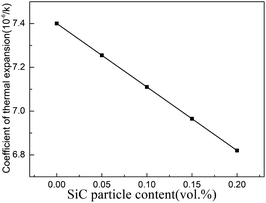 | ||
| Fig. 5 The change of thermal expansion coefficient of filler metal in the joint with the change of SiC particle content. | ||
Fig. 6 shows the fracture morphology of SiC ceramic brazed by Zr–Cu + SiCp composite filler metal with different content of SiC particles. It can be found that with the increase of SiC particles, the fracture of the joint presents ductile fracture. When the content of SiC particles is 15 vol%, the fracture of the joint is quasi cleavage. At this time, the fracture position is mainly in the interface reaction layer between SiC ceramic and Zr–Cu + SiCp composite filler metal.
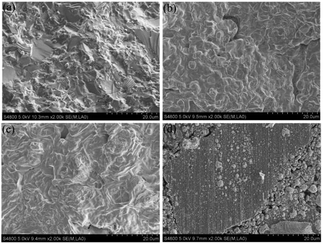 | ||
| Fig. 6 Fracture microstructure of SiC ceramic brazing joint with Zr–Cu + SiCp filler metal with different content of SiC particles: (a) 0, (b) 5 vol%, (c) 10 vol%, (d) 15 vol%. | ||
3.2. Microstructure and properties of joint with Zr–Cu + Mo composite filler metal
It can be found that the brazing of SiC ceramic can be realized with Zr–Cu + Mo composite filler metal with different content of Mo, and there are no voids, pores and other defects in the brazing seam when the brazing temperature is 1200 °C for brazing SiC ceramic with heating rate is 4 °C min−1 and the holding time for 20 min. The microstructure and element distribution of the interface between Zr–Cu + 9Mo (vol%) composite filler metal and SiC ceramic at 1200 °C are shown in Fig. 7. It can be found that an interface reaction layer with a thickness of about 5 μm is formed between the composite filler metal and SiC ceramic. It is inferred that the reaction layer is mainly ZrC and Zr2Si. This is mainly due to the strengthening effect of Mo in Zr–Cu composite filler metal, at the same time, the Gibbs free energy (ΔG) of the possible interfacial chemical reaction between the active element Mo and the Si and C atoms decomposed by SiC or SiC ceramic is shown in Fig. 8. It can be found that the most likely reaction is SiC + 11/3Mo = Mo2C + 1/3Mo5Si3, and the ΔG of the reaction is −109.4 ∼ −122.4 kJ mol−1 at 1000–1400 °C. According to the previous research results, it is found that the reaction between active element Zr and SiC ceramic is SiC + 3Zr = ZrC + Zr2Si, and the ΔG of the reaction is - 329.9 ∼ −324.3 kJ mol−1 at 1000–1400 °C. By comparison, it can be found that Zr is more likely to react with SiC ceramic, and the interface reaction products are mainly ZrC and Zr2Si. Through the distribution of interface elements, it is found that the reinforcing phase Mo is uniformly distributed in the composite filler metal layer. On the one hand, the thermal expansion coefficient of the composite filler metal is reduced by the addition of the reinforcing phase Mo, the main reason is that the thermal expansion coefficient of Mo is 5.7 × 10−6 K−1, which is between SiC ceramic (4.5 × 10−6 K−1) and Zr–Cu alloy (7.4 × 10−6 K−1). On the other hand, the thermal neutron absorption cross section of Mo is 2.5 × 10−28 m2, which is lower than that of Cu (3.59 × 10−28 m2), which effectively reduces the thermal neutron cross section of composite filler metal and improves the nuclear properties of filler metals and SiC ceramic brazed joint.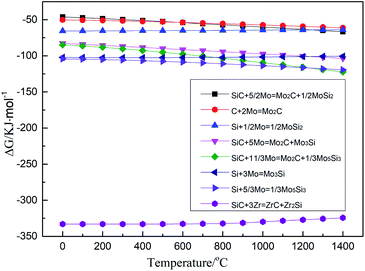 | ||
| Fig. 8 ΔG change of the possible interfacial chemical reaction between Zr–Cu + Mo composite filler metal and SiC ceramic with temperature. | ||
The shear strength of SiC ceramic joints brazed with Zr–Cu + Mo composite filler metals of the different Mo content is shown in Fig. 9. The shear strength of brazed joint increases with the increase of Mo content, and reaches the maximum (74 MPa) when Mo content is 6 vol%, with the increase of Mo content in Zr–Cu + Mo composite filler metals, the shear strength of brazed joint decreases. The reason is that Mo has no reaction with filler metal and SiC ceramic, and its solubility with Zr is also very small. It plays a dispersion strengthening role in filler metal and can hinder the growth of grain during high temperature brazing. When the content of Mo is 6 vol%, the dispersion strengthening is the most significant. With the increase of Mo content, the Mo element hinders the interfacial reaction between the solder and SiC ceramic, resulting in the decrease of joint strength.
The fracture microstructure of SiC ceramic brazed joint by Zr–Cu + Mo composite filler metals with different Mo content is shown in Fig. 10. The joint is brittle fracture when Mo element is not added, as shown in Fig. 10(a). The grain of the composite filler metal is obviously refined when Mo element is added to a certain content, as shown in Fig. 10(b) and (c). At this time, the main fracture is in the interface reaction layer area, which is ductile fracture. When Mo content in composite filler metal is 9 vol%, the fracture of brazed SiC ceramic joint is mainly at the joint of Zr–Cu + Mo composite filler metal and SiC ceramic, as shown in Fig. 10(d). This is mainly due to the high content of Mo in the filler metal hinders the interface reaction between the composite filler metal and SiC ceramic, resulting in incomplete interface bonding, peeling off in the weak part of the brazing, and bare SiC ceramic matrix.
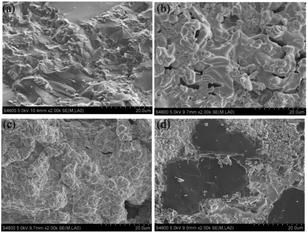 | ||
| Fig. 10 Fracture microstructure of brazing SiC ceramic joint with different Mo content of the composite filler metal: (a) 0, (b) 3 vol%, (c) 6 vol%, (d) 9 vol%. | ||
4. Conclusion
(1) The brazing of SiC ceramic can be realized successfully by Zr–Cu + SiCp and Zr–Cu + Mo composite filler metals.(2) SiCp is dispersed in Zr–Cu + SiCp composite filler metal, and a transition region with a certain thickness is formed in the interface. The main products of the interface reaction are ZrC and Zr2Si. The results show that the shear strength of SiC ceramic joint increases with the increase of SiC particle content in the composite filler metal, the shear strength of the joint reaches the maximum when the SiC particle content is 10 vol%, the average value is about 82 MPa, and the fracture of the joint presents ductile fracture,the strength of the joint decreases with the increase of SiC particle content in the composite filler metal, and the fracture of the joint is quasi cleavage.
(3) The addition of Mo with low expansion coefficient into Zr–Cu alloy can effectively adjust the thermal expansion coefficient and nuclear properties of composite filler metal and its joint. The interface products are mainly ZrC and Zr2Si, and the element Mo mainly plays the role of dispersion strengthening. The shear strength of the brazed joint increases with the increase of Mo content. When the Mo content is 6 vol%, the shear strength of the joint reaches the maximum (74 MPa), which occurs in the interface reaction layer and belongs to ductile fracture. With the increase of Mo content in composite filler metal, the joint strength decreases.
Conflicts of interest
There are no conflicts to declare.Acknowledgements
This research is financially supported by Hubei Education Department Program (No. Q20201802) of Hubei Province in China, Hubei Science and Technology Program (No. 2020CFB375) of Hubei Province in China, Doctoral Research Initiation Fund (No. BK201902) of Hubei University of Automotive Technology.Notes and references
- B. Christiaen, C. Domain and L. Thuinet, et al., Influence of Vacancy Diffusional Anisotropy: Understanding the growth of zirconium alloys under irradiation and their microstructure evolution, Acta Mater., 2020, 195, 631–644 CrossRef CAS.
- Z. Alkan, K. Kugeler and R. Kaulbarsch, Silicon carbide encapsulated fuel pellets for light water reactors, Prog. Nucl. Energy, 2001, 38, 411–414 CrossRef CAS.
- M. Hort and A. Malo, Detailed source term estimation of the atmospheric release for the Fukushima Daiichi Nuclear Power Station accident by coupling simulation of an atmospheric dispersion model with an improved deposition scheme and oceanic dispersion model, Atmos. Chem. Phys. Discuss., 2015, 14(10), 1029–1070 Search PubMed.
- R. Parekh, M. Kazimia and S. Skorupskib, Intestine transplantation across a positive crossmatch with preformed donor-specific antibodies, Transplant. Proc., 2016, 48(2), 489–491 CrossRef CAS.
- X. Dai, J. Cao and Z. Chen, et al., Brazing SiC ceramic using novel B4C reinforced Ag-Cu-Ti composite filler, Ceram. Int., 2016, 42(5), 6319–6328 CrossRef CAS.
- F. Moszner, G. Mata-Osoro and M. Chiodi, et al., Mechanical behavior of SiC joints brazed using an active Ag-Cu-In-Ti braze at elevated temperatures, Int. J. Appl. Ceram. Technol., 2017, 14, 703–711 CrossRef CAS.
- H. Li, W. Shen and Y. He, et al., Microstructural evolution and characterization of interfacial phases in diffusion-bonded SiC/Ta-5W/SiC joints, Ceram. Int., 2020, 46(14), 22650–22660 CrossRef CAS.
- K. Tenyama, M. Maeda and T. Shibayanagi, et al., Interfacial microstructure of silicon carbide and titanium aluminide joints produced by solid-state diffusion bonding, Mater. Trans., 2004, 45, 2734–2739 CrossRef CAS.
- H. Y. Dong, S. J. Li and Y. Y. Teng, et al., Joining of SiC ceramic-based material with ternary carbide Ti3SiC2, Mater. Sci. Eng., 2011, 176, 60–64 CrossRef CAS.
- H. P. Xiong, B. Chen and Y. Pan, et al., Joining of Cf/SiC composite with a Cu-Au-Pd-V brazing filler and interfacial reactions, J. Eur. Ceram. Soc., 2014, 34, 1481–1486 CrossRef CAS.
- J. Li, L. Lei and Y. Wu, et al., Microstructure of high temperature Ti-based brazing alloys and wettability on SiC ceramic, Mater. Des., 2009, 30(2), 275–279 CrossRef.
- W. B. Tian, Z. M. Sun and P. Zhang, et al., Brazing of silicon carbide ceramics with Ni-Si-Ti powder mixtures, J. Aust. Ceram. Soc., 2017, 53, 511–516 CrossRef CAS.
- B. F. Zhou, Z. C. Zeng and Y. C. Cai, et al., FEM simulation and verification of brazing SiC ceramic with novel Zr-Cu filler metal, Materials, 2019, 12(20), 3380–3388 CrossRef CAS.
- B. F. Zhou, J. F. Wang and K. Q. Feng, et al., Effect of brazing parameters on the microstructure and properties of SiC ceramic joint with Zr-Cu filler metal, Crystals, 2020, 10, 93–101 CrossRef CAS.
- B. F. Zhou and K. Q. Feng, Zr-Cu alloy filler metal for brazing SiC ceramic, RSC Adv., 2018, 8(46), 26251–26254 RSC.
- Q. Ma, Z. R. Li and Z. Y. Wang, et al., Relieving residual stress in brazed joint between SiC and Nb using a 3D-SiO2-fiber ceramic interlayer, Vacuum, 2018, 149, 93–95 CrossRef CAS.
- X. Y. Dai, J. Cao and Y. T. Tian, et al., Effect of holding time on microstructure and mechanical properties of SiC/SiC joints brazed by Ag-Cu-Ti + B4C composite filler, Mater. Charact., 2016, 118, 294–301 CrossRef CAS.
| This journal is © The Royal Society of Chemistry 2021 |

